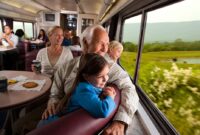Adventures for Seniors sets the stage for an exciting exploration of travel and activity options for older adults. This guide delves into various adventure types, catering to different fitness levels and preferences, ensuring that every senior can find a thrilling and safe experience. We’ll cover meticulous planning, essential safety measures, and the invaluable social benefits of shared adventures, providing a comprehensive resource for embarking on memorable journeys.
From carefully curated itineraries to budget-friendly options and accessible destinations, we aim to empower seniors to embrace new challenges and create lasting memories. We’ll examine the importance of physical and mental well-being throughout the adventure planning process and highlight community resources available to support these endeavors. Ultimately, this guide seeks to inspire seniors to pursue their adventurous spirit with confidence and joy.
Social and Community Aspects
Participating in group adventures offers seniors significant social and emotional benefits, enriching their lives beyond the physical activity itself. The shared experience fosters a sense of belonging and combats feelings of isolation, a common concern among older adults. These adventures provide opportunities for meaningful connections and lasting friendships.
Group adventures for seniors significantly enhance social interaction and companionship. The shared experiences, from navigating challenging trails to celebrating successes together, create strong bonds. This shared sense of accomplishment fosters camaraderie and mutual support, leading to improved mental well-being. Furthermore, the regular interaction within a group setting provides opportunities for seniors to build new friendships and strengthen existing ones, combating loneliness and promoting a sense of community. This social interaction is crucial for maintaining cognitive function and overall happiness.
Examples of Community-Based Organizations Offering Adventure Programs
Many community-based organizations recognize the value of adventure programs for seniors and actively offer such opportunities. These programs often cater to diverse interests and abilities, ensuring inclusivity. For instance, the Road Scholar program (formerly Elderhostel) offers a wide range of educational travel adventures designed specifically for older adults. These trips often incorporate cultural immersion, historical exploration, and outdoor activities, providing a rich and engaging experience. Similarly, many local parks and recreation departments offer walking clubs, hiking groups, and other outdoor activities tailored to the needs and capabilities of seniors. YMCA and other community centers often run similar programs, focusing on both physical and social aspects. These organizations provide a structured environment for seniors to connect with peers and engage in activities that promote both physical and mental health.
Choosing Compatible Travel Companions
Careful consideration of travel companions is crucial for a successful and enjoyable group adventure. Choosing individuals whose abilities and preferences complement each other ensures a positive experience for everyone involved. For example, pairing a senior with strong hiking experience with a less experienced individual can provide both support and encouragement. Similarly, selecting companions with similar interests, whether it’s a shared passion for history or a preference for relaxed pacing, can enhance the overall enjoyment of the trip. Open communication among potential travel companions before the adventure is essential to ensure that everyone’s expectations are aligned and potential challenges are addressed proactively. This careful planning contributes significantly to a safe, fulfilling, and memorable experience for all participants.
Budgeting and Affordability
Planning a senior adventure requires careful consideration of costs to ensure a fulfilling experience without breaking the bank. A well-structured budget allows for flexibility and peace of mind, transforming potential financial anxieties into confident anticipation. This section outlines strategies for creating a realistic budget and exploring cost-effective options.
Creating a Realistic Budget for Senior Adventure Trips involves a methodical approach. Begin by defining the scope of your adventure: trip duration, destination, and desired activities. Next, meticulously itemize expected expenses. This includes accommodation (consider nightly rates and potential discounts for seniors), transportation (flights, trains, buses, car rentals – factoring in fuel and tolls), activity costs (entrance fees, guided tours, equipment rentals), food (daily meal allowances), and incidental expenses (souvenirs, tips, unexpected costs). Use online budgeting tools or spreadsheets to track expenses and ensure your spending aligns with your allocated budget. Remember to build in a contingency fund for unforeseen circumstances.
Accommodation Costs
Budget-friendly accommodation options abound for senior travelers. Consider staying in hostels (many offer private rooms), guesthouses, or bed and breakfasts, which often provide a more personal experience than large hotels at a lower cost. Utilizing websites that compare prices across various accommodation types can yield significant savings. Additionally, exploring options outside major city centers can dramatically reduce accommodation expenses. For example, staying in a charming village near a popular tourist destination can offer a more authentic experience at a fraction of the price of a hotel in the city center. Senior discounts are frequently available, so always inquire about potential savings when booking.
Transportation Costs
Transportation costs can vary greatly depending on the chosen mode of travel and the distance covered. For shorter trips, bus travel can be significantly more economical than air travel. Consider utilizing train travel, especially for scenic routes, which often offers comfortable seating and onboard amenities. If driving, carpooling with fellow travelers can help reduce fuel and rental costs. For longer distances, budget airlines might be cheaper than traditional airlines, but always factor in baggage fees and other potential add-ons. Planning your itinerary to minimize travel time and distance can also result in significant cost savings.
Activity Costs
The cost of activities can significantly impact the overall budget. Prioritize activities that align with your interests and budget. Free or low-cost activities such as hiking, exploring local parks, visiting free museums (often offering senior discounts), and attending free community events can significantly reduce expenditure. Consider purchasing a city pass if visiting multiple attractions in a single city, as these passes often offer significant savings compared to purchasing individual tickets. Look for senior discounts on guided tours and other paid activities.
Comparing Costs Across Different Adventure Types
A multi-day guided tour, for instance, will generally be more expensive than an independent backpacking trip. A cruise might offer all-inclusive pricing, but this can be significantly higher than a land-based trip with self-catering options. A domestic trip within a country will typically be less expensive than an international adventure. Factors like the time of year (peak season versus off-season) and the level of luxury desired will also impact the overall cost. For example, a camping trip will be far less expensive than staying in a five-star resort. Careful planning and comparison shopping are key to finding the best value for your desired adventure type.
Destinations and Locations
Choosing the right destination is crucial for a successful senior adventure. The ideal location balances exciting activities with comfort and accessibility, ensuring a safe and enjoyable experience for all participants. Factors such as climate, ease of navigation, and the availability of appropriate amenities should be carefully considered.
Ideal destinations offer a blend of cultural immersion, breathtaking scenery, and manageable physical activity levels. This allows seniors to fully engage with the experience without undue strain or discomfort. The following sections detail suitable locations and the unique experiences they offer.
Five Ideal Destinations for Senior Adventures
Selecting the perfect destination involves considering several factors including climate, accessibility, and available activities. Here are five locations that cater well to the needs and preferences of senior adventurers:
- San Diego, California, USA: San Diego boasts a near-perfect Mediterranean climate, with warm, sunny days and mild evenings year-round. The city offers excellent accessibility with numerous wheelchair-accessible attractions and transportation options. Activities range from leisurely strolls along the beautiful beaches to exploring the historic Gaslamp Quarter and visiting the renowned San Diego Zoo, which provides convenient wheelchair rentals and accessible pathways.
- Quebec City, Canada: This charming city offers a rich European ambiance with cobblestone streets and historic architecture. While some areas may present slight accessibility challenges due to the old city’s layout, many attractions are accessible, and the city provides helpful resources for those with mobility limitations. The climate is moderate with distinct seasons, providing opportunities for sightseeing in the warmer months and enjoying the winter wonderland atmosphere. Activities include exploring the Citadelle, visiting the Plains of Abraham, and enjoying the city’s many charming cafes and restaurants.
- Barcelon, Spain: Barcelona combines stunning architecture, vibrant culture, and beautiful beaches. While some older parts of the city may have uneven pavements, the city is generally accessible, with public transportation offering options for wheelchair users. The climate is Mediterranean, with warm summers and mild winters. Activities range from visiting Gaudi’s architectural masterpieces to strolling along Las Ramblas and relaxing on Barceloneta Beach. The city also offers numerous accessible museums and cultural attractions.
- Costa Rica: For those seeking a more nature-focused adventure, Costa Rica offers a diverse range of accessible eco-tourism options. The country’s varied landscapes, from rainforests to beaches, can be explored with guided tours that cater to different fitness levels and mobility needs. The climate is tropical, with warm temperatures year-round. Accessible activities include visiting national parks, birdwatching, and enjoying relaxing spa treatments. Many eco-lodges offer accessible rooms and facilities.
- The Cotswolds, England: This picturesque region in England offers a charming blend of rolling hills, quaint villages, and historic sites. While some areas may involve walking on uneven terrain, many villages and attractions are accessible, and guided tours can be tailored to meet specific needs. The climate is temperate, with mild summers and relatively mild winters. Activities include exploring charming villages, visiting historic houses and gardens, and enjoying scenic walks (with options for shorter, less strenuous routes).
Destinations: Key Attractions, Accessibility, and Cost
| Destination | Key Attractions | Accessibility Features | Average Cost (per person, 7 days) |
|---|---|---|---|
| San Diego, CA | Balboa Park, Gaslamp Quarter, San Diego Zoo | Wheelchair accessible transportation, many accessible attractions, ADA compliance widespread | $1500 – $3000 |
| Quebec City | Citadelle of Quebec, Plains of Abraham, Old Quebec | Some areas may be challenging, but many attractions are accessible, assistance services available | $1200 – $2500 |
| Barcelona | Sagrada Familia, Park Güell, Las Ramblas | Generally accessible, public transportation options for wheelchair users, many accessible attractions | $1400 – $2800 |
Unique Cultural Experiences for Seniors
Many adventure destinations offer unique cultural experiences tailored to seniors. For example, in San Diego, seniors can enjoy relaxed whale watching tours, participate in gentle yoga classes on the beach, or explore the city’s vibrant culinary scene with accessible dining options. In Quebec City, seniors can partake in historical walking tours adapted for slower paces, attend traditional French Canadian music performances, and enjoy leisurely meals in cozy bistros. Barcelona offers accessible cooking classes featuring Catalan cuisine, guided tours of Gaudi’s works with consideration for mobility, and opportunities to engage with local artisans in accessible workshops. Costa Rica provides accessible nature walks with knowledgeable guides, opportunities for bird watching in adapted locations, and the chance to experience the country’s rich biodiversity without strenuous exertion. In the Cotswolds, seniors can enjoy traditional afternoon tea in accessible locations, attend local craft demonstrations, and explore historic houses and gardens at a relaxed pace. These examples highlight the many ways destinations cater to the specific needs and interests of senior adventurers, offering memorable and enriching cultural experiences.
Visual Representations
Visuals play a crucial role in inspiring and informing potential senior adventurers. Compelling imagery and well-designed infographics can effectively communicate the benefits and ease of embarking on exciting journeys, overcoming any perceived barriers to participation. The right visual approach can significantly impact the success of a senior adventure program.
A Visually Appealing Image of Seniors on an Adventure
Imagine a vibrant photograph depicting a group of smiling seniors hiking a gently sloping trail in a sun-dappled forest. The setting is a national park, perhaps Yosemite or Acadia, with towering trees framing a picturesque scene. The seniors, a diverse group in terms of age and ethnicity, are dressed in comfortable, yet practical, hiking attire – lightweight jackets, comfortable walking shoes, and hats to protect them from the sun. Some are engaged in conversation, while others are admiring the breathtaking views. One senior, perhaps in his seventies, is using a walking stick for added support, showcasing the accessibility of the activity. The overall mood is one of camaraderie, joy, and accomplishment, emphasizing the social and physical benefits of the adventure. The image is sharp, well-lit, and avoids any potentially negative connotations like strenuous activity or dangerous terrain. The focus is on the positive experience and the sense of community among the participants.
A Visually Engaging Infographic for Senior Adventure Planning
The infographic is designed with a clean, uncluttered layout, using a color palette of calming blues and greens to convey a sense of tranquility and nature. The steps are presented in a linear fashion, using clear icons and concise text.
Step 1: Destination Selection: A world map with highlighted destinations popular with senior travelers (e.g., national parks, charming coastal towns) accompanies this step. The text simply states “Choose Your Adventure!”
Step 2: Budgeting: A simple bar graph comparing potential trip costs (e.g., budget, mid-range, luxury) is shown alongside a brief description of cost considerations, such as flights, accommodation, and activities.
Step 3: Itinerary Planning: A calendar icon illustrates this step. The text emphasizes creating a flexible itinerary that accommodates seniors’ physical capabilities and preferences, allowing for ample rest and relaxation.
Step 4: Health & Safety: A first-aid kit icon paired with a checklist of important considerations, like travel insurance and any necessary medications, ensures preparedness.
Step 5: Packing: A suitcase icon represents this step, accompanied by a concise list of essential items for comfortable and safe travel.
Step 6: Enjoy the Journey!: A final image of happy seniors enjoying their adventure provides a positive and motivating conclusion to the infographic. This image could be a smaller version of the photograph described above, reinforcing the positive message throughout the visual representation.
Wrap-Up
Embarking on adventures as a senior is not just about ticking off destinations; it’s about enriching life experiences, fostering social connections, and challenging oneself in fulfilling ways. By carefully planning, prioritizing safety, and embracing the camaraderie of shared journeys, seniors can unlock a world of exciting possibilities. Remember, the journey is as important as the destination, and the memories created will last a lifetime. This guide serves as a springboard for unforgettable adventures, encouraging seniors to explore the world and themselves with renewed vigor and enthusiasm.




